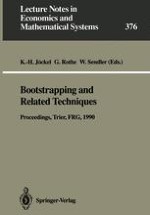
1992 | OriginalPaper | Buchkapitel
Principles for Generating Non-Uniform Random Numbers
verfasst von : Prof. Dr. Ulrich Dieter
Erschienen in: Bootstrapping and Related Techniques
Verlag: Springer Berlin Heidelberg
Enthalten in: Professional Book Archive
Aktivieren Sie unsere intelligente Suche, um passende Fachinhalte oder Patente zu finden.
Wählen Sie Textabschnitte aus um mit Künstlicher Intelligenz passenden Patente zu finden. powered by
Markieren Sie Textabschnitte, um KI-gestützt weitere passende Inhalte zu finden. powered by
In many simulations random numbers from a given distribution function F(x) with density f(x) = F′(x) are necessary. If f(x) = 1 for 0 ≤ x ≤ 1 uniformly distributed random numbers are needed. For this purpose the linear congruential method is widely used: A sequence of integers is initialized with a value z0 and continued as $$ {z_{{i + 1}}} \equiv a{z_i} + r\;(\bmod \,m),\;0 \leqslant {z_i} < m\;for\,all\;i $$ The fractions ui = zi/m are the derived pseudo-random numbers in the interval [0,1). The constants m, the modulus, a, the multiplicator, r, the increment, and z0, the starting number are suitably chosen non-negative integers. Three choices of m, a and r are common on most computers: 1.r = 0, m = 2E, a ≡ 5 (mod 8) and z0 ≡ 1 (mod 4). All zi ≡ 1 (mod 4) are generated.2.r = 0, m = p, p prime, a a primitive root mod p. All zi = 1,..., p − 1 are generated.3.gcd(r, m) = 1, m = 2E, a = 1 (mod 4). All integers 0, 1,..., 2E − 1 are generated.